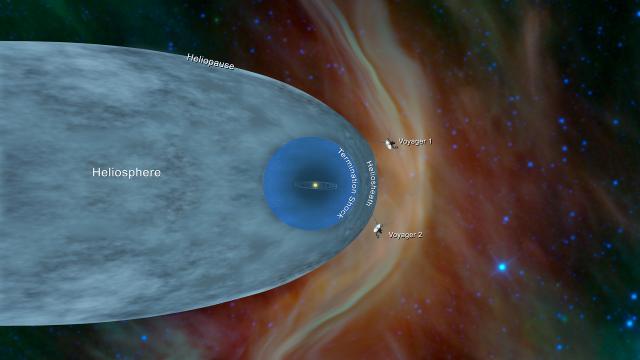A human-made object has entered the space between the stars for the second time in history, scientists report.
NASA will announce the details live at a press conference today at 11 a.m. ET, at the meeting of the American Geophysical Union (AGU) in Washington. You can watch the press conference live here.
NASA launched Voyagers 2 and 1 (it launched Voyager 2 first) in 1977 to explore Jupiter, Saturn, and the space beyond. Both probes returned tons of important information on the outer planets, and the missions have continued onward, taking measurements as they fly farther and farther through space.
Voyager 1 entered interstellar space in 2013, and we’ve known for months that Voyager 2 was getting close. In October, the probe measured the telltale sign of more cosmic ray particles striking its instruments. The Sun’s heliosphere, or the region where particles and magnetic fields are altered by the Sun’s influence, protects the crafts from these strikes. But after passing the heliopause, the furthest extent of the region, things should pick up. But Voyager project scientist Ed Stone said in October that “we’re not there yet.”
Well, we’re there now. The confirmation comes from the probe’s Plasma Science Experiment, according to a press release. It measured a steep decline in how fast solar wind particles were travelling since November 5, marking the exit.
Voyager 2 is over 11 billion miles from the Sun, travelling at 55,025km per hour away from its creators. It covers 290 million miles per year. But it hasn’t left the Solar System, according to the release—it has yet to enter the hypothetical Oort cloud of objects still influenced by the Sun’s gravity. That likely won’t happen for another 300 years, and it will take 30,000 years for Voyager 2 to fly beyond it.
The two missions will continue studying the region in interstellar space, NASA reports:
“I think we’re all happy and relieved that the Voyager probes have both operated long enough to make it past this milestone,” Suzanne Dodd, Voyager project manager at NASA’s Jet Propulsion Laboratory, said in the release. “This is what we’ve all been waiting for. Now we’re looking forward to what we’ll be able to learn from having both probes outside the heliopause.”
